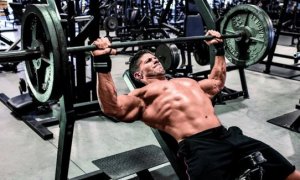Lower Pecs: Four Amazing Exercises for Your Lower Chest

The lower pecs are not hard to work out, but they are often neglected. This is because we tend to concentrate on the more visible parts of the upper body, like the shoulders. In this article, we will show you a routine for your lower pecs that will help you to achieve a balanced physique.
The lower pecs
The idea is to achieve symmetry throughout your entire chest. To do this, you will need a proper understanding of how to work out the lower pectoral muscles.
A common mistake is to begin your routine with the most exerting exercise. If you do this, you will not have enough strength to work out your other muscles. So, start with a press routine using dumbbells in a declined position.
The muscle fibers that come out of the upper pectoral muscle, extend to the lower part of your chest. These can be worked out with specific exercises targeting this area.
A routine for your lower pecs
If you have already worked out in a gym, you may be familiar with the following routine. The important part is to use proper form. If you need advice, do not hesitate to ask.
Push-ups

This traditional exercise is highly effective for building your lower pectorals. You can do push-ups using the following directions. Place your hands on the ground, a little more than shoulder-width apart. Extend your legs back, keeping your body firm and straight, letting its weight rest on your hands and feet.
Start by lowering your body to the ground by flexing at the elbows, and then push yourself back up to your initial position. You can gradually increase the intensity by adding weight on your back, or by doing more repetitions. This will help you to tone and strengthen the lower pecs.
Parallel bar dips
In order to perform this exercise, place your hands on the parallel bars with your palms facing inward. Next, support your weight with your arms, and cross your feet to flex your legs behind you.
Then, lean forward and flex your arms. Next, lower your body so that the arms are parallel to the ground. Now you can revert to your initial position and repeat the cycle.
There are gyms with machines that allow you to perform this exercise with assistance, in case you run out of strength. Crossing your legs and bending them back will help you push up and descend progressively.
Incline bench press

You can choose one of two implements: dumbbells or a bar. But while you learn the technique, your efforts will be focused on your lower pectoral muscles.
To achieve the desired effect, you need to adjust the bench so that the part supporting your head is behind your hips. Take the dumbbells with your arms outstretched and your hands over your chest.
Flex your elbows and lower the weight toward the lower part of your chest. Repeat the movements for several cycles, going up and down, extending your arms and flexing. The technique is very similar is you are using a bar.
Precaution: keep in mind that since there will always be weight on you during this routine, it is a good idea to have a spotter nearby.
Crossovers
This exercise is best performed using pulleys, so that your lower pecs sense the effort and are stimulated to grow. Stand between the machine’s pulleys, with the elastic ropes at the height of your head.
Now, grab a pulley with each hand, holding them by the handle. In order to truly work the lower pecs, you need to keep your elbows slightly bent, while keeping them firm the entire time.
Next, pull the weight inward so that your fists meet at your center, right in front of your hips. Keep it there for a few seconds before reversing the motion. Repeat the cycle about 10 times.
Your lower pecs deserve attention
If you devote part of your routine to strengthening and building your lower pecs, not only will you get a more defined physique, but you will also find it easier to do other, more demanding upper body exercises. This way, your chest will be entirely firm, and you will lay the groundwork to develop other muscles.
The lower pecs are not hard to work out, but they are often neglected. This is because we tend to concentrate on the more visible parts of the upper body, like the shoulders. In this article, we will show you a routine for your lower pecs that will help you to achieve a balanced physique.
The lower pecs
The idea is to achieve symmetry throughout your entire chest. To do this, you will need a proper understanding of how to work out the lower pectoral muscles.
A common mistake is to begin your routine with the most exerting exercise. If you do this, you will not have enough strength to work out your other muscles. So, start with a press routine using dumbbells in a declined position.
The muscle fibers that come out of the upper pectoral muscle, extend to the lower part of your chest. These can be worked out with specific exercises targeting this area.
A routine for your lower pecs
If you have already worked out in a gym, you may be familiar with the following routine. The important part is to use proper form. If you need advice, do not hesitate to ask.
Push-ups

This traditional exercise is highly effective for building your lower pectorals. You can do push-ups using the following directions. Place your hands on the ground, a little more than shoulder-width apart. Extend your legs back, keeping your body firm and straight, letting its weight rest on your hands and feet.
Start by lowering your body to the ground by flexing at the elbows, and then push yourself back up to your initial position. You can gradually increase the intensity by adding weight on your back, or by doing more repetitions. This will help you to tone and strengthen the lower pecs.
Parallel bar dips
In order to perform this exercise, place your hands on the parallel bars with your palms facing inward. Next, support your weight with your arms, and cross your feet to flex your legs behind you.
Then, lean forward and flex your arms. Next, lower your body so that the arms are parallel to the ground. Now you can revert to your initial position and repeat the cycle.
There are gyms with machines that allow you to perform this exercise with assistance, in case you run out of strength. Crossing your legs and bending them back will help you push up and descend progressively.
Incline bench press

You can choose one of two implements: dumbbells or a bar. But while you learn the technique, your efforts will be focused on your lower pectoral muscles.
To achieve the desired effect, you need to adjust the bench so that the part supporting your head is behind your hips. Take the dumbbells with your arms outstretched and your hands over your chest.
Flex your elbows and lower the weight toward the lower part of your chest. Repeat the movements for several cycles, going up and down, extending your arms and flexing. The technique is very similar is you are using a bar.
Precaution: keep in mind that since there will always be weight on you during this routine, it is a good idea to have a spotter nearby.
Crossovers
This exercise is best performed using pulleys, so that your lower pecs sense the effort and are stimulated to grow. Stand between the machine’s pulleys, with the elastic ropes at the height of your head.
Now, grab a pulley with each hand, holding them by the handle. In order to truly work the lower pecs, you need to keep your elbows slightly bent, while keeping them firm the entire time.
Next, pull the weight inward so that your fists meet at your center, right in front of your hips. Keep it there for a few seconds before reversing the motion. Repeat the cycle about 10 times.
Your lower pecs deserve attention
If you devote part of your routine to strengthening and building your lower pecs, not only will you get a more defined physique, but you will also find it easier to do other, more demanding upper body exercises. This way, your chest will be entirely firm, and you will lay the groundwork to develop other muscles.
All cited sources were thoroughly reviewed by our team to ensure their quality, reliability, currency, and validity. The bibliography of this article was considered reliable and of academic or scientific accuracy.
- Baig MA, Bordoni B. Anatomy, Shoulder and Upper Limb, Pectoral Muscles. In: StatPearls [Internet]. Treasure Island (FL): StatPearls Publishing; 2022 Jan.
- Calatayud J, Borreani S, Colado JC, Martín FF, Rogers ME, Behm DG, Andersen LL. Muscle Activation during Push-Ups with Different Suspension Training Systems. J Sports Sci Med. 2014 Sep 1;13(3):502-10.
- Lauver JD, Cayot TE, Scheuermann BW. Influence of bench angle on upper extremity muscular activation during bench press exercise. Eur J Sport Sci. 2016;16(3):309-16.
- McKenzie A, Crowley-McHattan Z, Meir R, Whitting J, Volschenk W. Bench, Bar, and Ring Dips: Do Kinematics and Muscle Activity Differ? Int J Environ Res Public Health. 2022 Oct 14;19(20):13211.
- Signorile JF, Rendos NK, Heredia Vargas HH, Alipio TC, Regis RC, Eltoukhy MM, Nargund RS, Romero MA. Differences in Muscle Activation and Kinematics Between Cable-Based and Selectorized Weight Training. J Strength Cond Res. 2017 Feb;31(2):313-322.
This text is provided for informational purposes only and does not replace consultation with a professional. If in doubt, consult your specialist.








